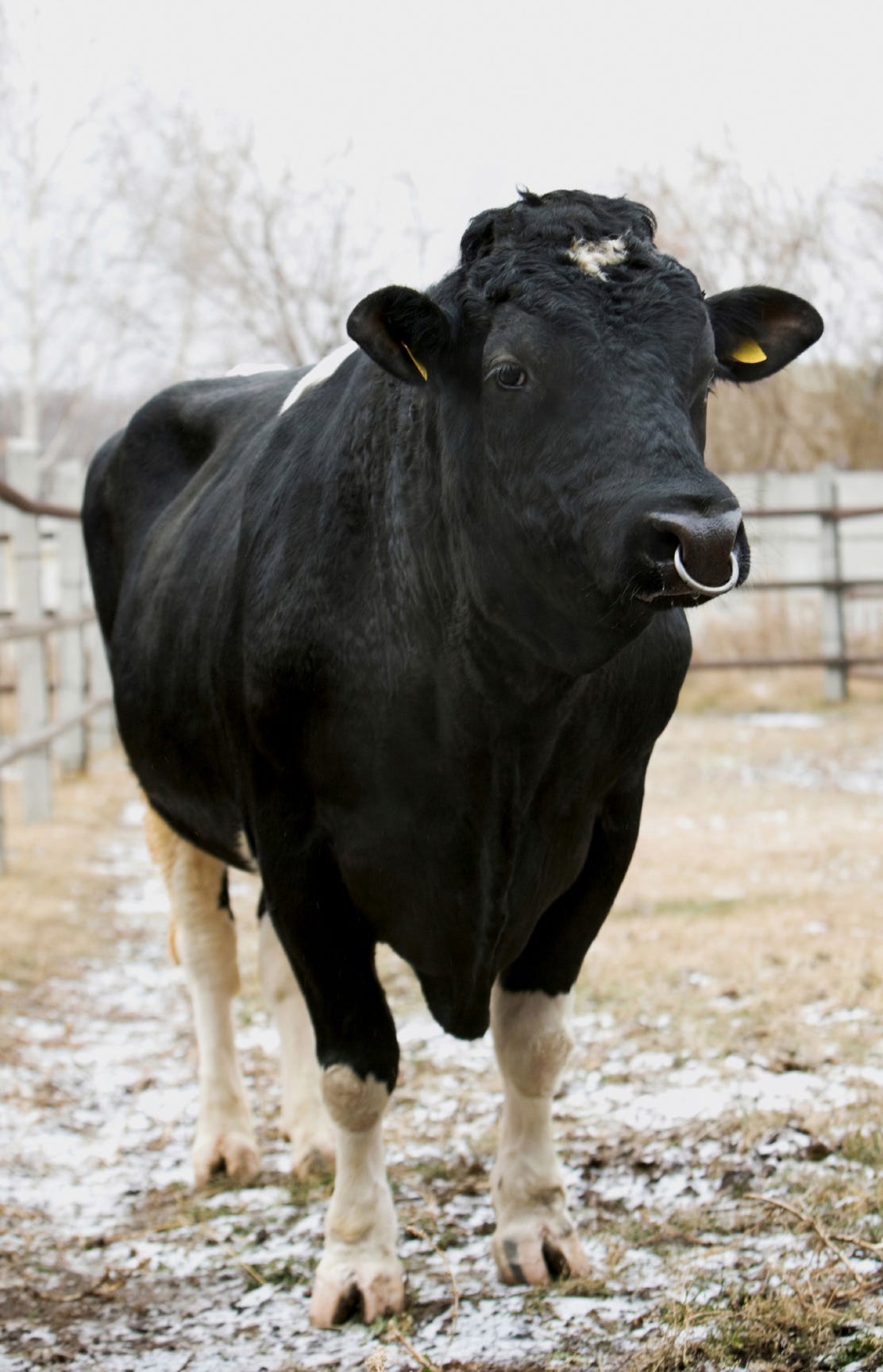No bull, these animals are dangerous
 Colleen Kottke
Colleen Kottke
More than 50 years later, MaryAnn Pahnke can still hear the sound of splintering timbers as their herd bull pummeled her younger brother against the wall of a pen he had fallen into.
"I grabbed a pitchfork and jumped in there and started jabbing him in the head," she said. "He reared up momentarily, with the tines still sticking in his head, and I was able to get my brother out of there."
Pahnke's brother was one of the those lucky enough to escape an attack by a bull. While there are countless "live to tell" stories like hers, unfortunately there are many more stories with a tragic ending.
Animal danger
Bulls, which account for only 2% of cattle, were responsible for 48% of the deaths from cattle, according to the U.S. Department of Labor Census of Fatal Occupational Injuries and the Surveillance of Occupational Injuries and Illnesses databases.
In 2000, six of 26 Wisconsin farm deaths involved animals – four of those six deaths involved bulls, according to statistics compiled by the University of Wisconsin Healthy Farmers, Healthy Profits Project.
Since then, bulls have killed at least 19 people in Wisconsin, according to UW Madison agricultural safety expert Cheryl Skjolaas.

Growing up on a farm near Stoughton, Skjolaas knows firsthand the dangers of having a bull on the property. She recalls heading down to the woods to bring up the cows for the evening milking when the herd bull became aggressive.
"I jumped into a nearby hay rack and sat there for a long time while the bull kept pushing his head up against the wagon, rocking it back and forth," she said. "My dad came home and realized no one was milking. When he started up the feeding system the cows and the bull headed up to the barn."
Skjolaas said her dad then drove the truck down to the woods to look for her.
"The next day the bull was gone," Skjolaas said.
AI vs. natural service
A study done in 2014 by the National Animal Health Monitoring System reviewed data from 17 states including Wisconsin on basic animal health and management practices. According to the data, 45.5% of surveyed operations used both AI and natural service (bull) while 10.7% of farms used bulls exclusively for breeding.
A lower percentage of small operations used both breeding methods compared with large operations (36.7 and 67.1 percent, respectively).
Since that survey, Paul Fricke, Extension Dairy Reproduction Specialist and Professor of Dairy Science at the University of Wisconsin – Madison says technology has changed the way farmers get cows bred.
RELATED: Bulldozed: Back from the brink of being crushed by a bull
"Farms are now using genomic testing, using sexed semen and beef semen at a much higher rate – all of these new technologies and new practices which pretty much exclude the use of bulls," he said. "In Wisconsin, at least, bull use is pretty low."

Fricke says the biggest reason that farmers continue to use bulls is perceived convenience and the perception that bulls outperform artificial insemination or will be a solution to reproductive problems on a dairy farm.
Tragedy waiting to happen
While bulls may appear to be a foolproof alternative to a producer's reproductive worries, they may be a tragedy waiting to happen – especially with dairy bulls that have a reputation for being dangerous as they age.
"As calves, they are bottle-fed by hand and imprint on people. When they get older they try to exert dominance over people, not cattle," said Temple Grandin, assistant professor of Animal Science at Colorado State University. "The bull that's going to kill you is the hand-fed, bucket calf."
Although some dairy bulls may appear calm, they may react unexpectedly, attacking people without provocation.
"Just because we've raised them and think we can read that animal, we forget that it's a prey animal and there are natural instincts and that herd mentality inside. And at some point in time it will take dominance in the herd, whether over another animal or you, that person that cared for it," Skjolaas said.
Veterinarian Dr. Paul Wardin, who raised test bulls on a family farm in Michigan, says most farms lack sufficient bull confinement and restraining facilities.

"We kept them in reinforced pens and led them around with machinery," said Wardin. "If you have a bull on a farm, at least have a ring in its nose so you have something to grab onto. A whack on the head with a stick won't slow a bull down. A bull's objective is to get you on the ground, and if they can get you on the ground you've had it."
Cattle, especially bulls, have a natural advantage over their caretakers simply due to their size. Skjolaas says bulls will exhibit signs of agitation if it feels threatened or is protecting his territory. A bull will display subtle warning signs before putting his head down and pawing at the ground.
"He will position himself broadside to you to show he has size and power. That's when you want to be moving out of that situation," Skjolaas said. "Slowly leave his flight zone. Never turn your back on a bull and run. He will chase you. "
Once a bull attacks and has his victim down on the ground, it will continue to pummel its quarry until it either someone diverts the bull or the person is dead. Skjolaas says one study estimates the head force of a mature bull at 1,900 lbs.
"That's why a lot of injury reports from attacks come back with victims suffering traumatic internal injuries," she said.
Skjolaas recalls a conversation with a veteran rescue worker who in her long career has responded to numerous crashes along the Interstate.
"She came upon the scene of a bull attack and could see from the blood splatters in the snow that the bull had continued to toss its victim repeatedly until the individual hit a fence. She told me she had never seen a more severely injured victim as the one she saw killed by the bull. She compared it to injuries sustained in a semi truck crash," Skjolaas said. "And afterwards the family chose to let the bull live."
Skjolaas says anytime a bull shows aggression it should be on the next truck heading to the slaughterhouse.
"In one particular case, a woman had been injured by her herd bull on a couple of occasions but decided to keep him because he 'threw good calves'," Skjolaas said. "A few years later they found her dead in the barn after being attacked by that same bull."
Not worth the risk
Bulls of breeding age are considered dangerous and those who own them should use special facilities for them and practice extreme caution when handling them.
Those working on small or large dairy farms using a natural service bull run the risk of injury. On small farms, young family members are often charged with moving groups of cows through holding pens.
"When they're small they don't have the physical mass to even scare a bull let alone recognize there's a danger out there," said former UW Extension agent Irv Possin.
Years ago when his three sons were small, Waupun dairy farmer Randy Bruins made the decision that having a bull wasn't worth the risk.
"We use artificial insemination, not only for better genetics but there is less danger," Bruins said. "At the time our sons were outside a lot and we didn't want to put them in that situation."
According to a Hoard's Dairyman study, dairies with the greatest frequency of bull-related injuries tended to be new dairies, large dairies and newly expanded dairies with new or unfamiliar management routines, often staffed with new employees not experienced with bulls and their behaviors.

Skjolaas says its important for farm owners to provide training for employees and new hires concerning animal behavior both with cows and bulls - whether it is in the parlor, freestall barns, pens or pasture.
"Take the time to cover the facility, showing them where the exits and gates are or pens to escape into," she said. "Employees should always assume that the bull is present and there is danger. It's important to never trust a bull or assume they are tame. They can turn on you quickly."
...if you still choose to use a bull
Bulls are dangerous and unpredictable and can seriously injure or kill their handlers or bystanders.
The following safety measures and practices are recommended for those using a natural service bull on their farm.
- Maintain constant awareness of the location and behavior of bulls when entering a holding area or pasture. Work with a partner if possible, rather than alone.
- Keep a safe distance from bulls, and learn to identify aggressive postures bulls exhibit before they attack.
- Bull handling facilities should be in good working order. All pens chutes, gates, fences and loading ramps should be strong and work properly.
- Bull handlers should be physically separated from contact with the bull, outside the area and protected by chutes, walls or other barriers.
- Escape passages should be in place to allow farmers to escape from animals in an emergency.
- Farmers should stay clear of animals that are frightened or "spooked" and be extra careful around strange animals.
- Cull aggressive bulls from the herd and, in general, do not keep bulls past 2 years old.
Source: Nancy M. Esser, Agricultural youth safety specialist, National Children's Center for Rural and Agricultural Health and Safety